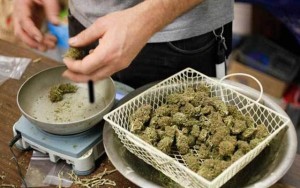Lisa Jennings of Nation’s Restaurant News reports that public restaurant companies have room for improvement when it comes to disclosing food-safety risks, and shareholders should consider how companies mitigate that risk before  investing.
investing.
Duh.
Chapman and I have both had short-traders call us in the past few weeks, all seemingly high on coke and awkward like Christian Bale in The Big Short.
They think they’ve found a new way to make money.
I just sigh, and anyone who’s read barfblog.com over the past 11 years could figure it out.
But I don’t have a New York business card and am awkward in my own way.
But if anyone wants to hire me to oversee their food investments, I’m available. Maybe I’ll just start my own foodsafetyfirst fund.
A new report from Cornerstone Capital Group called “Food Safety: In a State of Transformation,” commissioned by Investor Responsibility Research Center Institute, an independent research group that focuses on corporate governance.
“We definitely think there is room to improve,” said Mike Shavel, global thematic analyst with Cornerstone Capital, and one of the study’s authors. “Restaurants gave the least amount of disclosure throughout the food-supply chain. They really do need to take this more seriously in terms of providing disclosure to their customers, but also their investors.”
The report examined a number of food-safety events across the food industry over the last 25 years that have impacted public companies, from an E. coli outbreak at Jack in the Box in 1993, to a series of illness outbreaks at Chipotle Mexican Grill Inc. last year.
The food-safety practices and disclosures of about 60 companies across the food industry were evaluated, including grocery companies, meat and produce suppliers, food manufacturers, and distributors.
Looking at a sample of 14 publicly traded restaurant companies, which were not identified, the report found that the majority provided some detail on supplier management systems and noted food safety as a risk in annual reports.
But few disclosed information about internal safety systems and external food-safety certification practices, or the key performance indices tracked to measure performance.
Only one company tied executive compensation to food safety, and one had a board member with food-safety expertise, the report found.
Having a board member focused on food safety doesn’t diminish the fact that companies can hire experts, said Sebastian Vanderzeil, a Cornerstone Capital research analyst and a report author. But it does add a layer of credibility for restaurants, he said.
About half of the companies disclosed information about the traceability of ingredients, the report noted. And three companies disclosed sick-leave policies for workers.
Although the report avoided mentioning specific companies, a few were highlighted for notable practices.
For example, Starbucks Corp. has implemented a product traceability program that allows the company to track 100 percent of the raw materials in any product within four hours.
The report also cited Darden Restaurants Inc. for product traceability and setting leading supply-chain standards.
These are the sort of policies shareholders should ask about, Shavel said.
“They should say, ‘Starbucks has 100-percent product traceability within four hours. How fast can you do it?’ And let the company answer,” Shavel said. “That really informs you how the company thinks about food safety, and it if makes it to the C-suite level.”
The report also cited Panera Bread, Texas Roadhouse, The Cheesecake Factory and Jack in the Box for implementing Hazard Analysis and Critical Control Points, or HACCP, systems and food preparation protocols.
Chipotle, McDonald’s and The Cheesecake Factory were listed as disclosing sick-leave policies, although the report noted that the level of detail disclosed about such policies varies by company.
Such policies can be somewhat “fluffy,” Shavel said. Companies may say managers can adjust schedules if workers are not feeling well, for example.
But investors should look for formal policies with specifics on how workers can earn and use paid sick days, which Shavel argued is key in preventing norovirus-type illnesses that can spread when employees work while sick.
When restaurant chains make significant changes to their menu, investors should pay attention to how the company addresses the food-safety implications of such moves, Shavel added.
In addition, the report recommended that shareholders looking at any publicly traded food company consider asking the following questions:
- What internal systems are in place to support food-safety objectives? Is third-party certification required?
- What systems and certifications are required from suppliers?
- What formal food-safety staff training is required?
- Which technologies are being used to facilitate traceability throughout the supply chain?
- Who is the lead food safety person at the company and to whom do they report? Is there a food-safety committee within the company?
- How does the board oversee food safety? Which key performance indicators are reported, and how often are they provided?
I’ll add this: any company that wants my money has to be sending out its own investigators to really see what is going on in food safety. Walk the talk.

